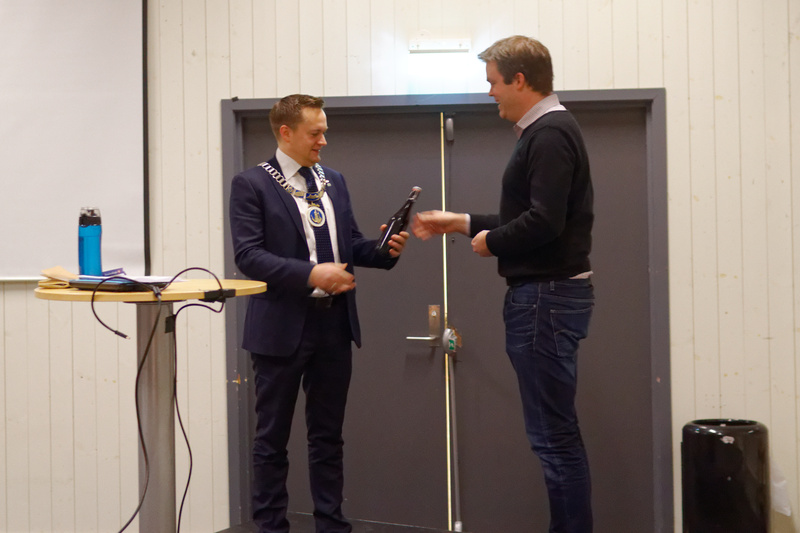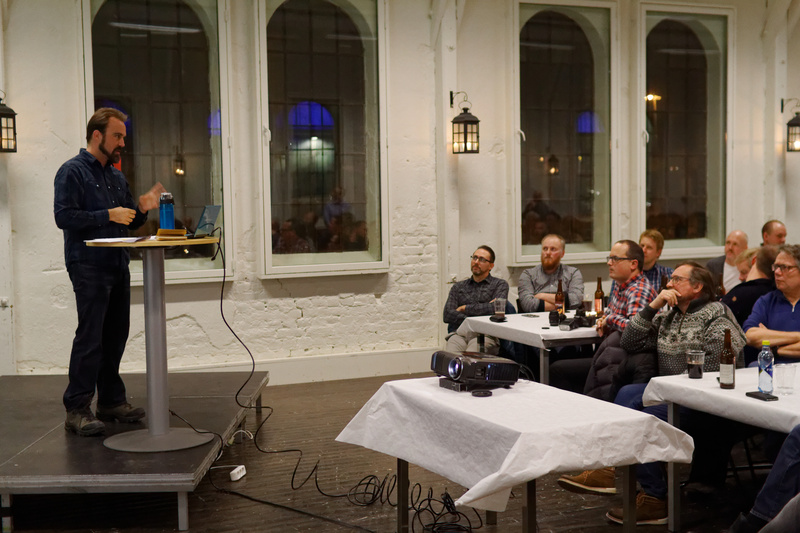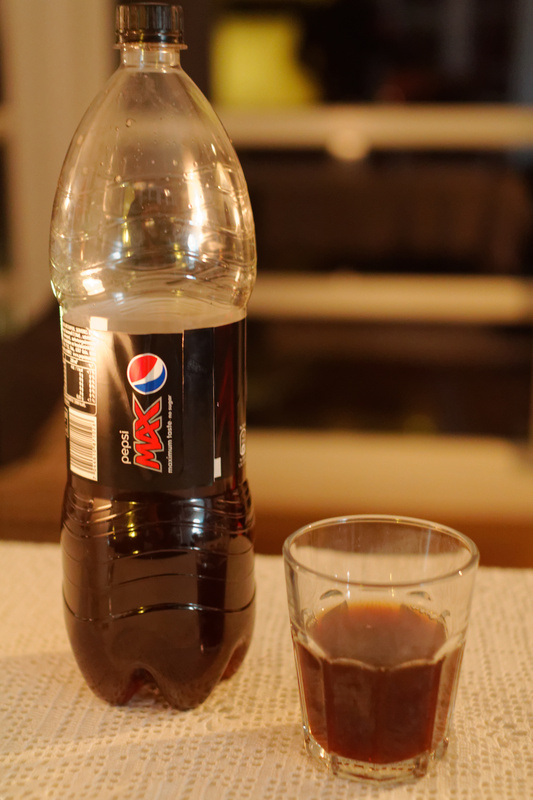Where the mayor makes his own malts

The mayor opening the meeting |
When Martin, Amund, and I were invited to visit Roar to explore the local beer style stjørdalsøl Roar figured that he might as well make use of the three visiting beer "experts," and have us do a set of talks for the local home brewing association. Which we of course happily agreed to do, even though this is an association at least as much for modern home brewers as for the traditional brewers. (This is the third part about the Stjørdalen visit in January 2016.)
They'd set it up as a rather grand affair, and the mayor himself came by to open the evening. I was a bit surprised by this, until the mayor started talking. He said a few words about the cultural importance of the local brewing, and then added that "Usually, when I do something like this I give the organizers flowers. But in this case I thought beer would be more suitable." At which point he took out a bottle and handed it to the chairman of the brewer's association. It turned out that the mayor is also a farmhouse brewer, and since this is Stjørdal, he of course makes his own malts, too. His father was a maltster and brewer, too.
The mayor ended his introduction by saying he really wanted to stay and hear the talks, but that he had a previous engagement. That turned out to be the annual brewing competition of the Centre Party in Stjørdal, where all the beers, of course, are traditional stjørdalsøl with home made malts. That tells you quite a bit about how engrained the brewing is in the local culture.
In fact, my only older source for the local brewing is the local history of the area, published in many volumes by Jon Leirfall, from 1968 onwards. And Jon Leirfall was of course also a member of the Centre Party, in fact one of the most prominent members the party has ever had.

The county coat of arms |
In 1983 Stjørdal county wanted a coat of arms, and while the eventual choice was a lindworm, a beer mug was proposed by Arne Stuberg, who was of course also a Centre Party member. The beer mug proposal was debated in all seriousness in the county council, before the lindworm was chosen. (A poll a month later showed the population as being 80% against the lindworm. How many favoured the beer mug is not recorded.)
Once the mayor was finished talking there was a short break, which Martin made good use of. He asked the mayor whether perhaps we could taste the leftovers from the Centre Party competition. Sure, the mayor said, of course we could. So we made an appointment to come pick them up the next day.

Martin speaking |
Then it was time for our talks, where the key point we were making was that stjørdalsøl is actually a unique thing in the beer world, and that it's extremely important that people in Stjørdal keep brewing it, because if they don't the world of beer is going to lose something irreplaceable.
To say that this was well received would be an understatement. The local stjørdalsøl has not really been very highly regarded in the area. Later that evening a local commercial brewery told me that they'd never tried to make a stjørdalsøl because many locals are deeply skeptical of this type of beer, so they assumed it wouldn't sell. Now, suddenly, "experts" from outside came visiting to tell the brewers that not only is their beer good, but it's a cultural treasure of the very highest order, something unique in the world of beer. We were quite popular that evening.
The next morning we drove by the farm where the Centre Party brewing competition had been. Apparently the mayor had placed third this year, which he was very pleased with, as last year he'd been in tenth place. "And I really deserved that," he said. It turned out they had left the four best bottles for us.

The mayor's beer |
Later that evening we tasted them at Roar's place. They were recognizably similar to the ones we'd had the night before, smoky, with red berries, some plum and jam flavours, and in some cases an ash-like flavour. One beer was lightly acidic, but still very nice. The ones that came fourth, third, and second were all good, but the winner was kind of thin, and dry, and lacking in character.
Roar revealed that this bottle we had received with the cap loose. He'd tried closing the cap, but after an hour there was a clear fizzing sound when he opened it again. So probably the beer had fermented in the bottle over night, losing its sweetness and some of the flavour. Very likely the reason is that these beers have such short fermentation times that there is still residual sugar left when the beer is kegged. We will be returning to this point later on.
Similar posts
Hegra maltøl at Granås Gård
Our final stop on the trip was actually the first to be planned
Read | 2014-09-09 17:20
Stjørdalsøl — the tasting
During our 2014 farmhouse ale expedition, Martin and I visited Stjørdal, a region in Norway famous for the many farmhouse brewers who still make their own malts in the traditional way
Read | 2017-03-09 14:58
Finding farmhouse ale in Norway
Quite a few people write to me, saying they're planning to visit Norway, and want to know where they can experience Norwegian farmhouse ale culture
Read | 2019-07-14 10:39
Comments
No comments.